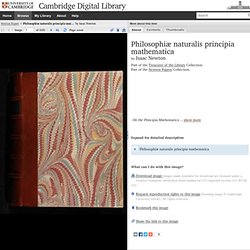

Gravity, Branes And Hidden Dimensions. Brian Greene: The Search For Hidden Dimensions. MIT 8.02 Electricity and Magnetism, Spring 2002. Cambridge Digital Library - University of Cambridge. 'Isaac Newton' Newton Papers On the Principia Mathematica Newton's monumental Philosophiæ Naturalis Principia Mathematica, often shortened to Principia, was published in July 1687 and brought him international fame.

In this three-part work, he lays out in mathematical terms his laws of motion and account of universal gravitation. Although he was able to provide a convincing description of the effects of gravitation, Newton failed to provide a sufficient explanation for why gravity occurred, so he sought to address this and other concerns by preparing a further edition. The book was severely damaged by fire and damp some time before it was given to the Library in 1872 as part of the Portsmouth collection. A BBC Radio 4 'In Our Time' discussion of Newton's laws of motion can be listened to here What are the novel ideas in the Principia Mathematica? Janna Levin: The sound the universe makes. Scientific Network.
Dr. Cynthia Breazeal - MIT Media Lab. Symphony of Science. Writing about exam worries for 10 minutes improves student results. It’s a feeling you’ve almost certainly experienced before – the fear of waiting for an exam to start, heart thumping, palms sweating and brow furrowing.

You worry about whether you’ve prepared adequately, and about the consequences of failure. So why not write these worries down? Gerardo Ramirez and Sian Beilock have found that students do better in exams if they spend the prior ten minutes writing about their worries. Even better, the most anxious students showed the biggest improvements. People often choke under pressure, performing far worse that they ought to. Beilock is something of an expert on these issues. At first, Ramirez and Beilock tested their solution in the laboratory.
Before they started the second test, half of the students sat quietly and the other half wrote openly about their thoughts and feelings on the pending exam. But was it the act of writing itself that did the trick? Their words contained a slew of negativity (“I am afraid I am going to make a mistake”).
The Story of Maths. Four part series about the history of mathematics, presented by Oxford professor Marcus du Sautoy.

In the first episode, The Language of the Universe, after showing how fundamental mathematics is to our lives, du Sautoy explores the mathematics of ancient Egypt, Mesopotamia and Greece. In Egypt, he uncovers use of a decimal system based on ten fingers of the hand, while in former Mesopotamia he discovers that the way we tell the time today is based on the Babylonian Base 60 number system. In Greece, he looks at the contributions of some of the giants of mathematics including Plato, Euclid, Archimedes and Pythagoras, who is credited with beginning the transformation of mathematics from a tool for counting into the analytical subject we know today.
The second episode, The Genius of the East, sees du Sautoy leaving the ancient world. When ancient Greece fell into decline, mathematical progress stagnated as Europe entered the Dark Ages, but in the East mathematics reached new heights. Portal:Astronomi.
Future Life On Earth. Biology. Technology. How Science Changed Our World.